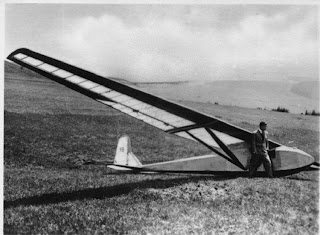Gliders/Soaring I.

This is coolbert:
In the aftermath of World War One [WW1], the victorious allied powers sought to military emasculate Germany. Germany was seen by the victors as having been an aggressive military power with formidable potential, a threat to all nations of Europe.
The Versailles Treaty called for drastic reductions in German military might. Conditions that a defeated Germany had to comply with. This was very humiliating and galling to the German, having the strong military tradition that they did.
Conditions to include:
* A reduction in size of the German army to a force NOT to exceed 100,000 men total.
* The sinking of the German Navy in totality. German warships were towed to the British naval base at Scapa Flow and sunk. Every last one of them. Germany was left without a navy.
[the German Navy had been the pride of Kaiser Wilhelm. Considered to be his creation.]
* NO air force. For a period of time subsequent to the war, the German was not even allowed POWERED flight. NO aircraft could fly, period.
However, with regard to NO air force or even POWERED flight, this DID NOT stop the German from engaging in flying, aeronautical engineering, experimentation with flight, etc.
NO. The NO-POWERED-FLIGHT conditions of the Versailles Treaty, rather than hindering the German, stimulated them. Stimulated them to investigate the realm of gliders and creating what is known as sport gliding.
"As the treaty of Versailles forbid any form of powered flight in Germany, many young pilots and aircraft designers turned to gliding as a sport"
"After the First World War gliders were built in Germany for sporting purposes (See link to Rhön-Rossitten Gesellschaft). The sporting use of gliders rapidly evolved in the 1930s and is now the main application. As their performance improved gliders began to be used to fly cross-country and now regularly fly hundreds or even thousands of kilometers in a day, if the weather is suitable."
We are not talking here about a glider as the term is commonly and ordinarily understood. We are talking about a glider that has been aerodynamically designed to be flown in a manner to maximize flight performance.
"Soaring is usually achieved by flying through a mass of air that is ascending as fast or faster than the sailplane is descending, and thus gaining potential energy."
With a conventional glider, the aircraft is taken aloft by a tow plane to altitude and release, rapidly descending to the ground, under control all the time by the pilot and being flown in a conventional manner.
With a "sport" glider, often called a SAILPLANE, the aerodynamics allow for a pilot, more correctly called a FLIER, to utilize rising air masses to achieve an altitude GREATER than with which the sailplane took of from.
[with a glider, you normally cannot land at an altitude GREATER than which with you took off from. YOU CAN ACHIEVE AN ALTITUDE GAIN WITH A SAILPLANE. That is the difference.]
"The design of these types enables them to climb using rising air instead of merely descending. This has created the sport of gliding, or soaring. The term 'sailplane' is sometimes used for these types, implying a glider with a high soaring performance."
"Glider pilots can stay airborne for hours. This is possible because they seek out rising air masses (lift) from the following sources":
* Thermals.
* Ridge lift.
* Mountain wave.
Mountain wave flying is a variation of ridge-running allowing the glider to climb much higher . . . The world distance record of 3008 km by Klaus Ohlmann was also flown in the mountain wave in South America.
[I want to emphasize this. The man achieved a distance record for un-powered flight of over 3000 kilometers in a sailplane. All in one flight!!! That is what can be done with a sailplane in competent hands!!]
[with wave lift, extreme altitude can also be reached. Altitudes of in excess of 50,000 feet!! Further altitude could be gained, but was precluded as the cabin of the sailplane was not pressurized. The pilot could go higher, but would die in the process!!!]
The German seems to have take to the sport gliding as a duck takes to water. Several generations of fliers, designers, manufacturers, etc., developed new techniques and concepts for a "sport" that was brand-new and NOT EVEN BEING DONE ANYWHERE ELSE!!!
AN ENTIRE REALM OF AERONAUTICAL ENDEAVOR PREVIOUSLY NOT EVEN CONTEMPLATED BECAME REALITY, ALL DUE TO THE RESTRICTIVE CONDITIONS OF THE VERSAILLES TREATY.
German sport gliding of course continued and was expanded under the Nazi regime. This was obviously seen as an excellent method of training fliers for the future Luftwaffe and creating again, a generation of aeronautical engineers and manufacturers whose skills soon would be utilized in the design and manufacturer of combat aircraft of the most advanced type.
"While under the Nazis, sailplane flying and training were taken over by the sport groups of the Hitlerjugend, research and glider construction continued in the new Deutsche Forschungsanstalt Für Segelflug (DFS) Up to world war II, RRG and DFS have been the main spearheads of German aeronautical design."
With the German and the development of sport gliding, we can see the adage "where there is a will, there is a way" is true!!
coolbert.
Labels: Gliders

0 Comments:
Post a Comment
Subscribe to Post Comments [Atom]
<< Home